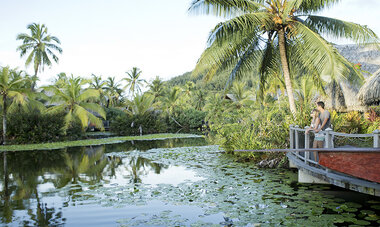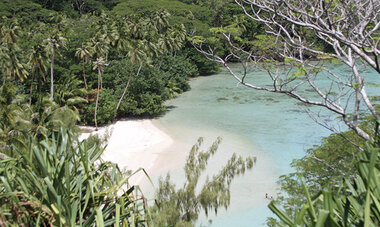
What to do on Huahine, the Secret Island
Your trip to French Polynesia should definitely include a stop on the island of Huahine, between Moorea and Raiatea. Just 40 minutes from Papeete (the capital of Tahiti) by air, Huahine is served by daily domestic flights. A few monthly ferries also take visitors to this very special island.
Huahine: a hidden gem
Almost half the size of Moorea, it has only a third of the inhabitants, totalling just 6,000. Huahine is a peaceful oasis in the Society Islands. While exploring the island, visitors often feel a powerful connection with nature, tapping into the unique "mana" of Huahine.
In Tahitian or Reo Ma'ohi, Huahine means the sex (Hua) of a woman (Hine). It is the easternmost island of the Raro Mata'i (Leeward Islands). The island is actually split into two parts: Huahine Nui (Big Huahine) in the north and Huahine Iti (Little Huahine) in the south. The majority of the population live in eight villages, which are distributed equally between the north (Fare, Maeva, Faie, Fitii) and the south (Maroe, Haapu, Parea, Tefarerii).
Fare is a small town where you can find all the services you need during your stay: vehicle hire, a bank, a post office, a supermarket, and more. For activities and excursions (boats, jet skis, guides, etc.), we recommend you ask once you're at your accommodation.
Unearthing history
To the northwest of the town, the Maitai Lapita Village hotel is truly a special place. In 1952, excavations in Huahine uncovered unique pottery fragments, the likes of which had never been found before in the region. This revolutionary discovery led to the identification of the existence of an ancient Polynesian society, the Lapita people, who were responsible for creating a particular type of pottery. Sites have now been identified from New Guinea to Eastern Polynesia, illustrating a long tradition of voyages spanning the vast Pacific Ocean aboard large double-outrigger boats.
Some key sites from this period of colonisation are found in the Society Islands, including Vaito'otia-Fa'ahia in Huahine. During the construction work on Bali Hai, the island's first hotel (1970s), several archaeological artefacts were discovered. Further exploration unearthed a major Lapita site, offering new insight into the lives of Huahine's first Polynesian settlers, who probably arrived 1400 years ago through the pass known as Ava Mo'a, opposite the hotel.
Museum displays were specially created to showcase the findings. Whether or not you are staying at the hotel, they are well worth a visit.

The lake, the Marae, and sacred eels
Huahine rivals Moorea as a hiker's paradise. We recommend dedicating at least one day of your trip to exploring these remarkable trails. And what better way to spend your time than discovering the wonders of the island by bike or boat? To make sure you don't miss any secret spots, you can always hire a guide. First stop: Fa'una Nui (big head) lake, famous for its brackish water, a rare natural curiosity in Eastern Polynesia. It once belonged to the royal family, and is known for its Ava (milkfish) and other prized fish, which were historically reserved for the ruling families.
On the road towards the village of Maeva, which runs along the lake, you can discover the Manunu Marae (ceremonial space), one of the island's many archaeological sites. The small museum set up in the Fare Pote'e (oval house) is both humble and fascinating.
To the south of the lake, you can admire the fish parks in specific areas of the lagoon. An ancient method to ensure a supply of fresh food, their construction is a testament to people's ability to adapt to their environment.
No trip to Huahine would be complete without paying your respects to the Puhi Tari'a. Famous for their "ears", these sacred eels can be admired near Fā'ie, in a stream running between the roots of the Māpē (local chestnut trees). They can grow to up to two metres in length, and their blue eyes are mesmerising. For the inhabitants of the island, their divine presence is a reassuring sign of prosperity.

A worthwhile detour
As you head towards Mārō'ē, the island soars up towards the sky. The road climbs steeply, and is best tackled on an e-bike. Otherwise you will need some serious pedal power! However, the viewpoint is worth the effort. It offers magnificent views of the landscape, the bay, the interior of the island, the irregular coastlines, and hundreds of types of green vegetation.
After passing Tefarerii, there is another viewpoint, this time facing the lagoon. Turquoise blues and greens intermingle to form an exquisite pattern, inviting you to swim. Huahine also has some stunning beaches and Motu (reef islets) where you can enjoy a dip in 28 °C water.

Souvenir shopping by the bay
By the small Mahuti Bay and at the edge of Parea, there are shops selling beautiful Pāreu (pareos) everywhere you look. Maison du Paréo, Baie du Paréo, Passion du Paréo: if you come back from the south of the island without a Pāreu, you are missing out. The Pāreu, a rectangle of fabric commonly worn as a skirt or dress throughout the South Pacific, famously appeared in Gauguin's paintings, including Tahitian Women on the Beach (1892).
In the very south of the island, facing the Ara'ara Motu, near the magnificent beach of Avea Bay and its turquoise lagoon with thick white sand, home to the celebrated Mahana hotel and its famous restaurant, the Anini Marae makes an interesting stop. Standing next to the Titoi Marae, this royal Marae was dedicated to the god 'Oro and to sacrifices. Its altar (Ahu), made up of small platforms, is considered a resting place for the gods.
Before returning to Fare, we recommend a stop at Huahine Passion, the island's distillery. You can pick up a delicious souvenir to share when you get home, in addition to the hundreds of photos and memories of hikes, activities on the lagoon, beaches and Motu.